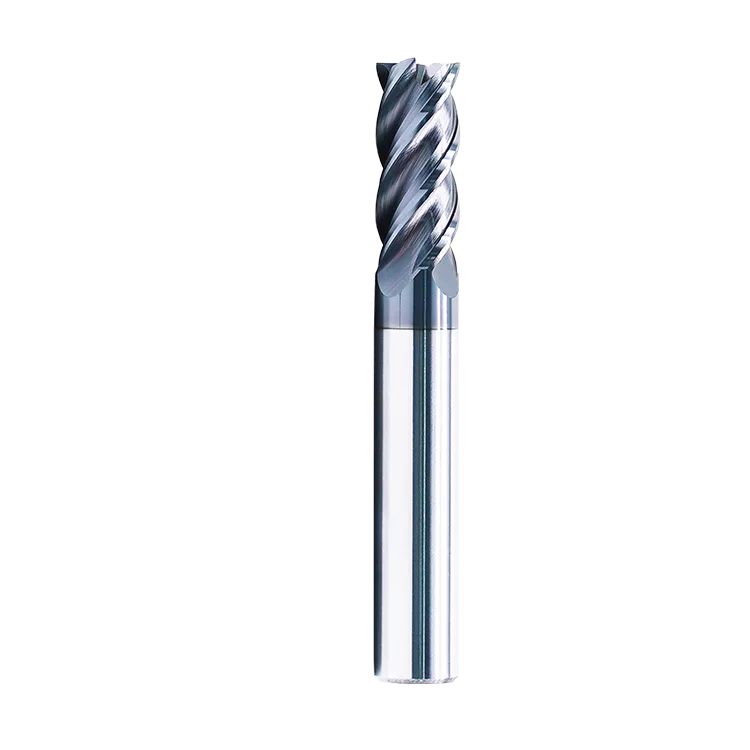The choice between 2-flute and 4-flute end mills is a critical decision in CNC machining, influencing performance, efficiency, and part quality. While both tools share the fundamental purpose of material removal, their design differences lead to distinct behaviors across cutting forces, chip evacuation, surface finish, and tool life. This article explores these disparities with a focus on dynamic stability, material-specific optimization, and emerging machining strategies, offering actionable insights for precision engineers and manufacturers.
| 2-Flute End Mills | 4-Flute End Mills |
 |
 |
1. Core Design and Structural Dynamics
The number of flutes directly dictates the end mill’s core diameter and flute valley geometry, creating a trade-off between rigidity and chip-handling capacity.
Key Structural Differences
-
2-Flute End Mills:
- Larger flute valleys enable 60% more chip clearance compared to 4-flute designs .
- Thinner core reduces rigidity, making them prone to deflection in heavy cuts but ideal for high-speed machining (HSM) of soft materials like aluminum .
- Example: A 12mm 2-flute end mill for aluminum achieves 226 m/min cutting speed with minimal heat buildup .
-
4-Flute End Mills:
- Thicker core provides 28% higher torsional rigidity , reducing deflection in steel and titanium alloys.
- Smaller flute valleys limit chip evacuation efficiency, necessitating lower feed rates in roughing operations .
- Example: A 11mm 4-flute carbide end mill for steel maintains ±0.005mm radial runout during high-load milling .
Dynamic Stability Insight:
Recent research on vibration control highlights that 4-flute end mills exhibit lower harmonic resonance due to their symmetric design, while 2-flute tools leverage asymmetric flute spacing to disrupt chatter in thin-walled applications .
Recent research on vibration control highlights that 4-flute end mills exhibit lower harmonic resonance due to their symmetric design, while 2-flute tools leverage asymmetric flute spacing to disrupt chatter in thin-walled applications .
2. Cutting Performance and Material Compatibility
The interplay between flute count, material hardness, and machining strategy determines optimal tool selection.
| Material | 2-Flute End Mill | 4-Flute End Mill |
|---|---|---|
| Aluminum/Non-Ferrous | Dominates due to 35% reduced cutting forces and efficient chip evacuation . Used in aerospace components (e.g., 6061-T6 slotting). | Less common; preferred for fine finishing (e.g., aluminum heat sinks with Ra < 0.8μm) . |
| Steel/Stainless Steel | Suitable for plunge cutting and roughing but limited by rigidity. | Optimized for high-feed milling (e.g., 0.003–0.004" IPT in 4140 steel) . |
| Titanium/Inconel | Struggles with heat buildup; 4-flute tools with variable helix angles (e.g., Sandvik CoroMill 690) excel in deep slotting . | Recommended for high-speed machining (HSM) with coolant pressure ≥ 0.7 MPa . |
| Plastics/Composites | High-helix 2-flute designs (40° helix) prevent melting and burr formation . | Used for low-deflection profiling in rigid setups. |
Emerging Trend:
In titanium machining, 4-flute end mills with asymmetric tooth spacing (e.g., 93°/87° angles) reduce chatter by 40% compared to symmetric designs .
In titanium machining, 4-flute end mills with asymmetric tooth spacing (e.g., 93°/87° angles) reduce chatter by 40% compared to symmetric designs .
3. Surface Finish and Machining Strategies
The number of flutes directly impacts the surface roughness (Ra) and the feasibility of advanced machining techniques.
Finish Quality Comparison
-
2-Flute End Mills:
- Produce coarser finishes (Ra 1.6–3.2μm) due to fewer cutting edges engaging the workpiece.
- Ideal for roughing passes and 3D contouring where chip evacuation is critical .
-
4-Flute End Mills:
- Achieve superior surface finishes (Ra 0.4–1.2μm) through multi-edge engagement and reduced vibration .
- Recommended for finish milling and tight-tolerance features (e.g., medical implants).
Machining Strategy Tips
-
High-Speed Cutting (HSM):
- 2-flute tools excel in aluminum HSM at 20,000–30,000 RPM, with feed rates up to 3,000 mm/min .
- 4-flute tools dominate steel HSM with helical interpolation for slotting depths ≥ 3×D .
-
Vibration Mitigation:
- For 2-flute tools, use variable pitch (e.g., alternating 71.5°/72.5° spacing) to disrupt harmonic resonance .
- 4-flute tools benefit from high-pressure coolant (≥ 10 MPa) to flush chips and stabilize cutting edges .
4. Tool Life and Cost Optimization
Tool longevity and operational costs depend on flute count, material, and cutting parameters.
Tool Life Factors
-
2-Flute End Mills:
- Shorter lifespan in hard materials due to higher edge stress.
- Outperform in soft materials (e.g., aluminum) with 3× longer life when coated with diamond-like carbon (DLC) .
-
4-Flute End Mills:
- Extended life in hard alloys (e.g., Inconel) due to load distribution across multiple edges.
- Require frequent regrinding in gummy materials (e.g., 304 stainless steel) to prevent edge buildup .
Cost Analysis
- Initial Investment: 4-flute end mills cost 15–20% more than 2-flute counterparts .
- Operational Savings:
- 2-flute tools reduce per-part costs by 22% in aluminum production through higher feed rates .
- 4-flute tools lower regrinding frequency by 30% in steel machining .
5. Future Directions and Advanced Applications
Innovative Tooling Solutions
-
Multi-Material Machining:
Hybrid approaches (e.g., 2-flute roughing + 4-flute finishing) optimize both efficiency and quality in titanium-aluminum stacks . -
Digital Twin Integration:
AI-driven tool wear prediction models (e.g., Sandvik CoroPlus) now account for flute count variations to extend tool life by 15–20% . -
High-Precision Additive Manufacturing:
4-flute end mills with micro-grain carbide (grain size < 0.5μm) enable ±5μm tolerance in post-processing 3D-printed parts .


